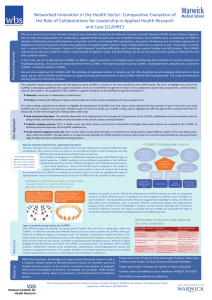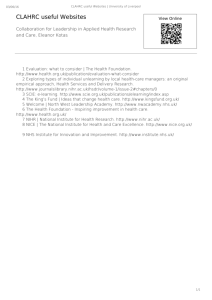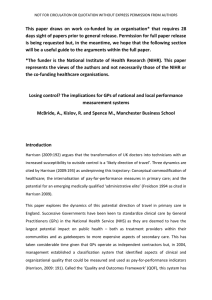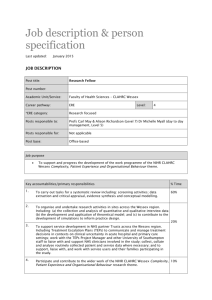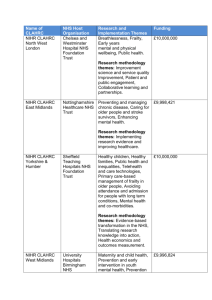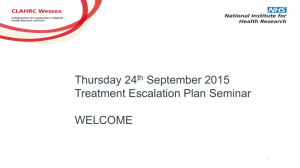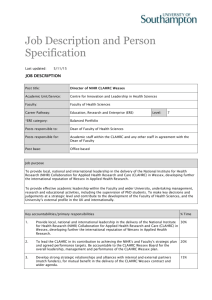Document 12182250
advertisement
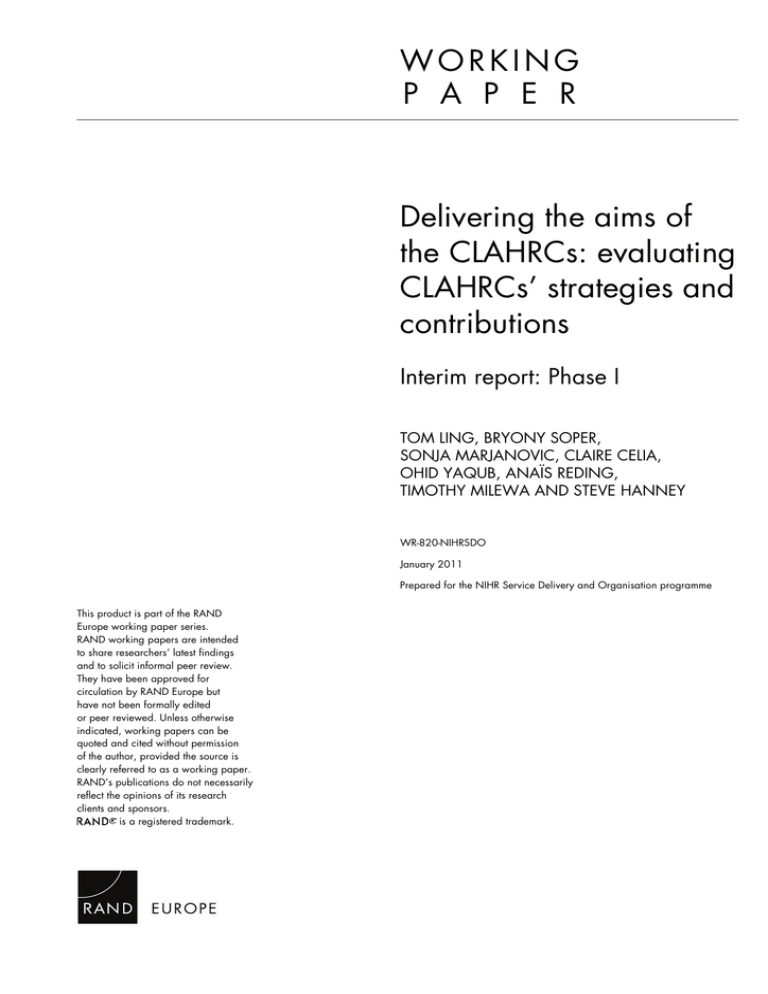
WORKING P A P E R Delivering the aims of the CLAHRCs: evaluating CLAHRCs’ strategies and contributions Interim report: Phase I TOM LING, BRYONY SOPER, SONJA MARJANOVIC, CLAIRE CELIA, OHID YAQUB, ANAÏS REDING, TIMOTHY MILEWA AND STEVE HANNEY WR-820-NIHRSDO January 2011 Prepared for the NIHR Service Delivery and Organisation programme This product is part of the RAND Europe working paper series. RAND working papers are intended to share researchers’ latest findings and to solicit informal peer review. They have been approved for circulation by RAND Europe but have not been formally edited or peer reviewed. Unless otherwise indicated, working papers can be quoted and cited without permission of the author, provided the source is clearly referred to as a working paper. RAND’s publications do not necessarily reflect the opinions of its research clients and sponsors. is a registered trademark. Executive Summary Nine CLAHRCs were established in 2008, with funding for up to £10m for five years This report catalogues work undertaken in the first phase of an evaluation of the nine Collaborations for Leadership in Applied Health Research and Care (CLAHRCs) established in October 2008 by the NIHR. The CLAHRCs aim to encourage and strengthen collaboration between universities and local NHS organisations so that patient outcomes are improved through the conduct of applied health research and its implementation. Each of the nine CLAHRCs, established in October 2008, will receive up to £10m over five years. The names, lead organisations and academic partners are listed in the table below. Name of CLAHRC Lead NHS Organisation Academic Partner(s) NIHR CLAHRC for University Hospital University of Birmingham Birmingham Birmingham & Black Country NHS Foundation Trust NIHR CLAHRC for Cambridgeshire & Cambridgeshire Peterborough Mental Health University of Cambridge & Peterborough Partnership NHS Trust NIHR CLAHRC for Greater Salford Teaching Primary University of Manchester Manchester Care Trust NIHR CLAHRC for Leeds, York & Bradford Leeds Teaching Hospitals NHS Trust University of Leeds University of York NIHR CLAHRC for University Hospitals of University of Leicester Leicestershire, Northamptonshire Leicester NHS Trust & Rutland NIHR CLAHRC for North Chelsea & Westminster NHS Imperial College London West Foundation Trust London NIHR CLAHRC for Nottinghamshire Healthcare University of Nottingham Nottinghamshire, Derbyshire & NHS Trust Lincolnshire NIHR CLAHRC for South West University of Exeter NHS South West Peninsula University of Plymouth Peninsula Medical School NIHR CLAHRC for South University of Sheffield Sheffield Teaching Hospitals Yorkshire Sheffield Hallam NHS Foundation Trust University xv Our evaluation approach is based on understanding the causal mechanisms through which CLAHRCs intend to deliver benefits An evaluation should provide evidence to explain what was done and what the consequences were. It should also support a judgement about whether this contribution was worthwhile. In pursuit of this aim, our approach is underpinned by developing an understanding of what each CLAHRC is seeking to achieve and why the CLAHRCs think their projects will work (their ‘theory of change’). In collaboration with the CLAHRCs we then aim to map out the sequence of events connecting their actions to their intended impacts (often known as ‘logic modelling’). Behind this approach lies the belief that projects and interventions have effects because they trigger causal mechanisms whose effects may be masked, undercut, or amplified by different contexts. Our evaluation is neither intended nor expected to be a complete evaluation of all of the CLAHRCs. Three other teams are conducting evaluations based on institutional theory, implementation research theory, and network theory respectively. Each explores specific aspects of the CLAHRCs. The CLAHRCs are also undertaking their own internal evaluations. There will therefore be available a range of evaluative evidence from across all the evaluations to support overall conclusions and judgements. In our first phase of research, we found that the intended outputs, outcomes and impacts of the CLAHRCs became clearer than they were at the start of the initiative. In a variety of ways, CLAHRCs are each seeking to change the way research is done and the way the NHS uses research in commissioning, managing and delivering services. However, the diversity of approaches is significant: important differences are emerging between the CLAHRCs. These include how stakeholders relate one to another, how cultures and values are changed, and how infrastructures are developed to support the CLAHRC. The existing literature is rich and suggestive but lessons are difficult to transfer to the CLAHRCs We know that the gap between the outputs of the health research system and actual practice in health care is substantial. However, although the problems have long been recognised, and were reiterated in the UK in the Cooksey Report (HM Treasury 2006), evidence on how to solve the problem is patchy and often difficult to act upon. Despite a variety of empirically rich literature to learn from1 the evidence base for decision makers still has important limitations. This is sometimes because evidence is not described in sufficient detail for lessons to be transferred, or sometimes because the contextual factors are inadequately identified so that their generalisability is limited. In Chapter 2 we report on a review of the literature and of some of the programmes to encourage evidence-based care that preceded the CLAHRCs. The factors thought to be associated with success include: strong leadership; a favourable political conjuncture and careful management of tensions; and successfully satisfying the different needs of participating institutions. The literature also suggests that complex projects take considerable time to become established; often requiring more than five years to demonstrate impacts. 1 e.g. Greenhalgh et al. 2004; Estabrooks et al. 2008; Mitton et al 2007; Wilson et al 2010; Damschroder et al. 2009; Hanney et al 2007; Eccles et al. 2005; Grol et al. 2007 xvi In the wider literature, there are notable contributions to understanding knowledge transfer and exchange. These stress the interactive processes between research users and research producers, the role of dissemination and communication, the implementation of new knowledge, and organisational change needed to accommodate this. We also considered sociological contributions to the framing, mediation and utilisation of evidence. This sensitised us to an important dimension relating to CLAHRCs: that the reception and use of evidence is shaped by communities of practitioners (Milewa and Barry, 2005; Ling, 2010). This is of central importance to the CLAHRCs. What counts as evidence, and how different evidence should be prioritised, varies in different groups such as: clinicians, managers, researchers, expert patients, the public and policy makers. The literature identifies logic models as a useful way of understanding complex interventions such as CLAHRCs Models can help frame our understanding of interventions such as CLAHRCs. Models facilitate communication and focus attention on the key steps along the causal pathways. In this sense they describe key elements in a process (see Figure 1 below). A theory of change based on such a model sets out the building blocks needed to deliver a programme goal and explores the assumptions about the underlying logic of the CLAHRC (Connell and Kubish, 1998; Weiss, 1995). A theory of change-based evaluation helps build a detailed understanding of both how and why a desired change is expected to occur in a specific context (Pawson and Tilley, 1997), and within such an approach, logic modelling provides a useful evaluation and learning tool. Logic modelling was popularised in the 1990s as a way of capturing complex initiatives and graphically illustrating program components to help stakeholders clearly identify outcomes, outputs, inputs and activities (i.e. processes, interventions) (Proteous, Sheldrik and Stewart, 2002). In keeping with Greenhalgh et al’s review (2004), we agree that models should be evidence based to be useful. And in keeping with Powell, Rushmer and Davies (2009), we agree that logic models for CLAHRCs should recognise that CLAHRCs pragmatically select different aspects of varying intervention approaches, and then apply them to the local context. In phase 1 of our evaluation we applied this approach to the CLAHRCs as they became established and started to deliver change CLAHRCs are not pre-defined entities. Our approach recognises that each CLAHRC is created by the people and groups in it. Our experience of the CLAHRCs to date has been that much effort has been focused on this construction process itself. In phase 1 of our evaluation we aimed to understand these changes and to identify key questions for phase 2. We recognise that not only does each CLAHRC have to be built by the people in it but also it involves a diverse set of activities which have progressed to different degrees and which more or less cohere. Consequently, we need to qualify evaluation questions such as ‘How, and how effectively, do CLAHRCs support local health service research and practice?’ in favour of a more nuanced approach, asking ‘What various activities have been done to construct and maintain CLAHRCs?’, ‘What consequences have these activities had for the behaviour of research producers and research users?’ and ‘How might these behaviour changes influence health services and patient care?’. However, whilst recognising that CLAHRCs are very diverse, their initial funding and establishment coupled with their subsequent mutual learning means that we can identify some over-arching features. Our current overview (which will continue to evolve) is summarised in Figure 1. xvii Fig 1 xix We are confident that this overarching view is well-founded but our detailed understanding of individual CLAHRCs is more provisional than we hoped it would be when we began phase 1. First, we were encouraged to share data collection with another evaluation team in order to limit the burden on the CLAHRCs. This led to problems in securing access to all the interview transcripts. Secondly, for understandable reasons, the CLAHRCs were not equally accessible, so we have more data on some than on others. Thirdly, the CLAHRCs continued to evolve as they adapted to learning, local pressures and national priorities; none claims to be ‘the finished article’. Despite these challenges, we have had access to widespread written materials from SDO and the CLAHRCs, and have interview transcripts from almost fifty key informants from across all the CLAHRCs. We have attended meetings in all the CLAHRCs except Birmingham and Black Country, and South Yorkshire, both of which politely declined the offer to be involved. Most of the meetings involved workshops ranging from two to four hours in length. Despite these limitations, from evidence gained from the CLAHRCs, and from the wider literature, we may identify and organise their activities and associated challenges into three broad categories. These are: structural and political; cultural, educational and normrelated; and infrastructure-related. Each CLAHRC is attempting to create a systematic shift in the relationships between health research and health care and uses a variety of activities under each of these categories. This reflects an emerging understanding which we hope to strengthen in further phases of the study. Structural and political: ‘Political’ in this sense relates to how stakeholders with different interests, goals and identities can work together in pursuit of common goals, or how disputes and conflicts are managed and resolved. Failure to address this political challenge would most likely lead to key stakeholders abandoning or disrupting the project or to short term compromises leading to long-term problems. It is especially relevant because CLAHRCs involve changing practices in ways likely to privilege some stakeholders or interests over others. CLAHRCs have worked creatively to establish governance and accountability arrangements to provide structures for decision making and discussion, along with implementing new organisational structures. Specific activities range from seeking to establish new personal and professional goals to establishing new, stable networked structures to support communication, negotiation and change among research users and research creators. Across the CLAHRCs, there is a variety of combinations of centralised structures for setting direction, combined with devolved responsibility. Too much centralisation may stifle creativity while too little may lead to incoherence and entropy. Approaches to centralisation and devolution vary across different CLAHRCs. Equally, different ways of managing dual R&D governance systems (NHS and academic) within the CLAHRC structure are still being developed (including mechanisms for releasing individual time to contribute to CLAHRC activities). All CLAHRCs have secured some agreement from partners for themes designed to fit with local and/or national healthcare priorities. Within this agreement, the relative weight of xx research delivery versus research implementation varies. Equally, while all CLAHRCs are pursuing joint working and learning across different themes, the activities and structures through which link one theme to another are varied. The comparative emphasis on generating new research evidence, as opposed to implementing existing streams of evidence in services, also differs across the CLAHRC landscape and, indeed, this balance may be changing over time. In addition, CLAHRCS recognise that they are part of a broader landscape of health service improvement activities. This creates both opportunities for greater impact from synergies between multiple national and regional efforts, as well as challenges associated with identifying complementarities and coordinating activities. Most CLAHRCs are also facing challenges associated with changes in the broader political landscape and its impact on the organisation of health services (e.g. changes in commissioning). Similarly, the ways by which NHS commissioners and managers are integrated into processes for identifying research questions in CLAHRCs, and implementing results, should be explored further. CLAHRCs all identify the continuation of funding beyond the first round as key for sustainable impact. Cultural, educational and norm related: All CLAHRCs also identify the need to change attitudes and norms of both individuals and groups, and to mobilise multiple stakeholders around a common mission. The ‘recruitment’ of leaders and managers who are experienced with working across NHS and academic boundaries, and investments into ‘training’ the next generation of such ‘boundary spanners’, have been central to this effort. According to one CLAHRC, at least, the creation of organisational cultures to support collaboration between different disciplines, professions and stakeholder groups is equally important. Some examples of mechanisms to change culture and norms include joint project work in multidisciplinary teams, meetings designed to share thinking, secondments, fellowships, engaging patients and the public, and raising the profile of applied research amongst clinical and academic staff. By the end of our Phase 1, cultural changes appear to have happened in pockets within organisations, but the scalability of such change (and variables influencing it) remains to be explored. The extent to which the leadership of CLAHRCs is clinically or academically driven, as well as the nature and scale of NHS senior and middle management involvement in CLAHRC activities, is another area we hope to better understand through the next phase of our research. Similarly, there is scope to further explore the influence of patients and the public on how research and implementation activities unfold: early insights suggest there is substantial diversity in the scale and scope of expert patient and public involvement across the CLAHRCs. Infrastructure Finally, each CLAHRC is aware of the importance of building an infrastructure able to sustain and support their activities (including information technology and financial systems). This includes finding ‘smarter’ ways to make optimal use of existing resources, as well as investments in new infrastructure. Some CLAHRCs (or themes within them) are pursuing co-localisation strategies and perceive this to be a significant enabler of multidisciplinary collaboration. In others, individuals and organisations operate through more virtually connected environments. Most CLAHRCs are investing in improving IT xxi systems for data storage, sharing and general communication between different stakeholders. Next steps Phase 2 of our evaluation is to investigate CLAHRC processes in more detail and to focus on key questions. We could not investigate all the processes in each CLAHRC so to help us prioritise we developed pragmatic criteria. The aspects we wanted to examine should be: relatively under-researched (as identified through our literature review) potentially high impact with transferable lessons relevant to the success of the CLAHRCs not covered by one of the three other evaluations capable of being researched across more than one CLAHRC to support comparisons and contrasts. Within these pragmatic criteria we developed research criteria drawing on our assessment of individual CLAHRCs, together with inputs from the wider literature and our advisory group. We shall re-engage with our Advisory Group and include the CLAHRC Directors and the SDO in a discussion about the final selection. The long list is as follows: 1. How do CLAHRCS fit into the broader translational research and implementation landscape of the NIHR (and other funders) at present, and how might they fit in the future? 2. High levels of NHS involvement underpin the CLAHRC ethos and theory of change. What is the real scale and scope of NHS involvement in CLAHRCs, and at what levels? How does the nature and extent of NHS involvement influence their evolution, outcomes and impacts? 3. What is the impact of different governance and management structures on CLAHRCs’ activities and outputs? 4. What levels of operational flexibility do CLAHRCs need in order to deliver on their goals effectively, and how is such flexibility best enabled and nurtured? 5. How are effective multiple-stakeholder and multidisciplinary research and implementation teams for service improvement built? What can we learn from the CLAHRC model and what mechanisms are being used to enable this? 6. What are the different models of public and patient engagement at play in CLAHRCs? What value has PPI brought? 7. What can we learn from the CLAHRCs that can cast new understanding on how to use research knowledge and evidence to change commissioning and clinical behaviour for patient benefit? 8. What value does a CLAHRC bring to the different stakeholders involved? What does it mean to different parties? The final selection from these questions, derived from our study so far, will form a basis for launching Phase 2. xxii
